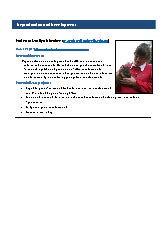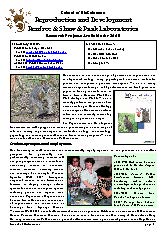Research Projects
Handouts for Prospective MSc and Honours Students
Molecular and endocrine control of hypospadias
Disorders of sexual differentiation (DSDs) are amongst the most common birth defects (1 in 4,000) births but malformations of the phallus are the most common and overt signs of impaired male differentiation. Hypospadias, the ectopic opening of the urethra, affects 1 in every 125 live male births in Victoria. The frequency of hypospadias is increasing internationally and in Australia. For example, in the two decades up to 2000, there was a 2% increase p.a.in its incidence in WA. Endocrine disruptors with oestrogenic activity in the environment may contribute to this increase. Hypospadias is caused when the urethral folds fail to close normally during fetal development and its severity depends on the location of the urethral opening. Despite its extraordinary prevalence, the only real option for affected boys at present is surgical intervention at 6-24 months of age. In most mammals, penile development is hard to investigate experimentally as it occurs in the fetus. We are capitalising on marsupials where sexual differentiation, including penile development, occurs post-natally. Our ongoing research has already generated new paradigms with the discovery that some sex differences have a sex-specific genetic origin independent of gonadal hormones. We recently discovered an alternative pathway for androgen biosynthesis, the first new steroid hormone pathway described in the last 50 years. This pathway has now been demonstrated in mice and humans and has been translated into medical practise in a new Endocrine Society (USA) Clinical Guideline. Our demonstration that penile development occurs as a result of androgens acting in a time-window well before morphological differentiation starts is inspiring further studies, providing new understanding of virilisation and providing explanations for clinical defects of virilisation, the majority of which are currently of unknown aetiology. The overall goal of this project is to provide new data on the interactions of the hormones and morphogens essential for penile patterning and growth, using a unique model and controlled endocrine disruption to induce hypospadias.
Germ cell development
Germ cells carry the genetic information from one generation to the next. To date, most of our knowledge of the development of mammalian germ cells and particularly the process of spermatogenesis comes from the mouse and, to a lesser extent, the human. Gonocytes have been termed “the forgotten cells of the germ cell lineage” because they are the intermediate stage between primordial germ cells (PGCs) and the formation of the much better studied oogonia or spermatogonia. However, even in these species, little attention has been given to gonocyte development, and virtually nothing is known about this process in marsupials. Our special advantage in using a marsupial model is that, in contrast to the mouse and human, marsupial gonocyte development occurs postnatally, so our aim is to characterise gonocyte development in these mammals. We can readily culture marsupial gonads in vitro during the critical stages of germ cell development that occur in utero in eutherian mammals, and we can induce male-to-female gonadal sex reversal both in vivo and in vitro. These special attributes of the marsupial thus provide a unique approach to investigation of the early stages of gonocyte development and differentiation. Defining the molecular signals that mediate germ cell development will improve our understanding of errors that affect health and fertility.
Cell lineage specification in the early embryo
How embryos specify the earliest cell lineages is a central problem in developmental biology. The molecular mechanisms that govern the segregation of the extraembryonic lineages and the maintenance of pluripotency in the embryonic lineage have been the focus of much intense research in recent years. Most advances have been made using the mouse as a model. However, the degree to which findings are applicable to mammals as a whole or even to other vertebrates is not clear. We have recently shown several major differences in the expression of key regulators of pluripotency and lineage-specific markers between marsupial and mouse that bring into question the evolutionary robustness of early developmental gene regulatory networks. Using a marsupial, the tammar wallaby, we propose to define the features of early development that are highly conserved among mammals and those that are evolutionarily plastic. We aim to achieve this by examining differences in global gene expression as well as the regulatory elements that control the expression of specific key genes. This information will greatly enhance our understanding of the evolution of early developmental mechanisms and reveal those that are under high evolutionary constraint and thus more fundamental.
Molecular control of embryonic diapause
We typically think of embryos as undergoing a continuous process of cell division and differentiation, but this is not always the case. Some species of mammals are able to override this normal pathway, placing the early embryo in a suspension of embryonic growth at the blastocyst stage, known as embryonic diapause, from which it can later be reactivated to complete development. Diapause occurs in about 100 mammal species including rodents, deer, bats, seals and marsupials. In the tammar wallaby, diapause typically lasts for 11 months, with no cell division or cell death and no loss of competence for future development. This project is using a comparative approach with mouse and tammar blastocysts, with cutting-edge proteomics, metabolomics and bioinformatics to characterise the regulatory pathways underlying diapause. Understanding the fundamental mechanisms underlying embryonic diapause will clarify some of the basic controls of cell division and differentiation that will lead to fresh insights and progress in diverse fields such as embryology and assisted reproduction, stem cell biology and oncology.
Evolution and function of genomic imprinting
Every cell has a double set of chromosomes, one inherited from the mother and one from the father. For most genes the maternal and paternal copies of each gene are activated or inactivated in parallel. However for some genes there is selective inactivation based on the parent of origin – the maternal copy being active whilst the paternal copy is silenced, or vice versa. This genomic imprinting, mediated by epigenetic mechanisms such as histone acetylation and DNA methylation, plays a vital role in normal embryogenesis and development, and abnormal imprinting can lead to embryonic death or disease syndromes. Imprinted genes have only recently been described in marsupials, while none have been discovered as yet in monotremes. In eutherian mammals, imprinted genes occur in clusters, and many have complementary or opposing actions. Most imprinted genes can be found in the placenta but we have also found imprinted genes in the mammary gland. There are many hypotheses to explain genomic imprinting, and marsupials, being distantly related to eutherians mammals and with a less invasive placenta, will help to clarify the evolution of genomic imprinting. Another aspect of genomic imprinting is the epigenetic reprogramming of the germ cells. Epigenetic reprogramming is an essential process to restore totipotency and to reset genomic imprints during germ cell development in mammals. The erasure and re-establishment of the methylation imprint in the germ line are the essential processes resetting the same parental allele-specific methylation pattern for the next generation. The dynamic change of DNA methylation at the DMRs (differentially methylated regions) within imprinted domains, and of retrotransposons, is characteristic of this process. Using methylation analysis, analysis of LTRs (long terminal repeats) and non-LTR retrotransposons it is possible to determine when germ cell demethylation and remethylation occurs. We have recently examined the reprogramming of the male germ cells, but as yet nothing is known of reprogramming the female germ cells in any marsupial. These projects will involve molecular biology (cloning, sequencing, quantitative-PCR, tissue culture and in situ hybridisation) and immunohistochemistry, methylation analysis, cell sorting and histology, as well as some animal handling. Our studies on genomic imprinting in marsupials are leading to new models for the evolutionary origins and developmental roles of these key processes.
Control of growth and development
The placenta regulates the growth and development of the mammalian fetus prenatally, but the mammary gland is critical for the supply of nutrients after birth. Embryonic and fetal growth is regulated mainly by Insulin-like growth factors, while growth hormone (GH) regulates post-natal growth. Marsupials give birth to young that are very undeveloped – altricial – and they complete most of their development in the pouch. However, it is possible to alter the rate of development of the young by transferring, or fostering, the young to the pouch of a mother producing a richer milk that supports an older young. Marsupial milk changes its composition throughout lactation, so using cross fostering techniques it is possible to begin to understand which specific milk components can affect growth. This project seeks to understand the control of growth in the developing mammal using the marsupial as a model.

